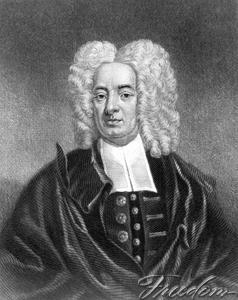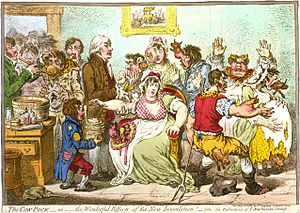The Grave Stone of a Smallpox Vaccine Victim, Reads:In Memory of Peleg, son of Thomas & Mary Conklin, who died of the smallpox by inoculation Jan. 27th, 1788; aged 17 years.
From The Lancet, Volume 348, Issue 9031, Page 902, 28 September 1996

I heard two neighbours talk the other night
About this new distemper-giving plan
Which some so wrong, and others think so right
Short was the dialogue, and thus it ran:
“If I had twenty children of my own,
I would inoculate them every one.”
“Aye, but should any of them die, what moan
Would then be made for venturing thereupon!”
“No, I should think that I had done the best,
And be resigned whatever should befal.”
“But could you really be quite so at rest?”
“I could.” – “Then why inoculate at all?
Since to resign a child to God , who gave,
Is full as easy and as just a part,
When sick, and led by nature to the grave,
As, when in health, to drive it there by art.”
Written by Dr. John Byrom, of Manchester UK, who died in 1763.
THE HISTORY OF VACCINATION

Rev. Cotton Mather (1663-1728), who Performed The First Vaccinations in 1721
Many people including the medical establishment incorrectly ascribe the practice of vaccination to Edward Jenner, but in actual fact, it had been in practice years before he carried out his first vaccination on the 14th May, 1796.
As you can see from the above poem, its author died in 1763 and it had obviously been written some time before that. It is thought to have originated in Turkey and was first practiced in the USA and UK in 1721.
Rev. Cotton Mather was not a doctor, but a vicar and an intensely religious and superstitous man who was heavily involved in the Salem witch trials and who murdered traditional medicine women by burning them at the stake because he suspected them of doing black witchcraft. His reasoning, therefore, that people did not die of smallpox if they were exposed to an entirely different disease – cowpox – is in keeping with his superstitous nature.
Mather’s job was to convince the Governor of Massachusetts, Sir William Phips (1651-1695)to believe in evil spirits and invisible beings for the purposes of trying ‘witches’ at his court. Mather wrote about it in his essay ‘Memorable Providences, Relating to Witchcrafts and Possessions’ (1689).
Anyone today would say that was total nonsense and if someone were to do the things he did they would probably be put in a secure hospital for the rest of their lives.
To read more about Cotton Mather, see:
Levin, David. Cotton Mather: The Young Life of the Lord’s Remembrancer, 1663-1703. Cambridge, MA: Harvard University Press, 1978.
Lutz, Norma Jean. Cotton Mather. Philadelphia: Chelsea House Publishers, 2000.
Silverman, Kenneth. The Life and Times of Cotton Mather. New York: Harper & Row, 1984.
Wendell, Barrett. Cotton Mather. New York: Chelsea House, 1980.
Mather had heard about vaccination performed on slaves in Africa and so he managed to persuade a local doctor, Dr. Zabdiel Boylston, to experiment with it. They did the vaccinations, which then involved cutting the arm and putting infected cow pus into the wound, known as variolation, on Boylston’s 6 year old son, his slave and his slave’s son. All three reacted terribly, got ‘smallpox'(or possibly cowpox since the pus was from cows) and became ‘gravely ill’ and at death’s door for several days. Then they recovered. Despite this, Mather took this as ‘proof’ that vaccination worked, because they didn’t die!
( Allen, Arthur (2007). Vaccine: The Controversial Story of Medicines Greatest Lifesaver. New York, NY: W.W. Norton & Company, Inc.. pp. 25–36).
They then began inoculating lots of people in the town of Boston, USA. They reported a fiercesome epidemic of smallpox where 100 people a week were dying out of a population of 15,000. This figure was contested by the towns people who said it had been made up to justify vaccination. It was written:
‘At a meeting by public authority in the Town House of Boston, before His Majesty’s Justices of the Peace and the Select Men; the practitioners of physic and surgery being called before them, concerning Inoculation, agreed to the following conclusion:—
A Resolve upon a debate held by the physicians of Boston concerning inoculating the Smallpox on the 21st day of July, 1721.
It appears by numerous instances, that it has proved the death of many persons soon after the operation, and brought distempers upon many others which have in the end proved deadly to ’em.
That the natural tendency of infusing such malignant filth in the mass of blood is to corrupt and putrefy it, and if there be not a sufficient discharge of that malignity by the place of incision, or elsewhere, it lays a foundation for many dangerous diseases.
That the operation tends to spread and continue the infection in a place longer than it might otherwise be.
That the continuing the operation among us is likely to prove of most dangerous consequence.
The number of persons, men, women, and children, that have died of smallpox at Boston from the middle of April last (being brought here then by the Saltertuda’s Fleet) to the 23rd of this instant July (being the hottest and worst season of the year to have any distemper in) are, viz.—2 men, strangers, 3 men, 3 young men, 2 women, 4 children, 1 negro man, and 1 Indian woman, 17 in all; and those that have had it, some are well recovered, and others in a hopeful and fair way of recovery.’
By the Select Men of the Town of Boston.
(The Story of a Great Delusion, by William White, LONDON: E. W. ALLEN, 4 AVE MARIA LANE. 1885).
So the towns people say only 17 were affected by smallpox.
Many members of the public and doctors of the time stated that it was actually inoculation that caused much of the ferocious epidemic.
Vaccinators admitted to up to 2% of people inoculated died, but justified that by saying more people died of natural smallpox. If the public meeting of the towns people is an accurate record, then those death rates are inflated, and they didn’t take into account those who had recieved variolation could transmit the infection to others and would have spread the epidemic.
It also spread other blood bourne diseases like syhphilis and TB and they don’t count that in their estimation of how many people died following variolation because the 2% is the figure for who died of smallpox. When you take into account all the other diseases and permanent disabilities it caused, variolation was not safer at all.
Baylor University Medical Center Proceedings, wrote:
‘However, inoculation was not without its attendant risks. There were concerns that recipients might develop disseminated smallpox and spread it to others. Transmission of other diseases, such as syphilis, via the bloodborne route was also of concern.’
(Proc (Bayl Univ Med Cent). 2005 January; 18(1): 21–25 – http://www.ncbi.nlm.nih.gov/pmc/articles/PMC1200696/).
People of the time also argued that those who had been inoculated were specially selected and were in robust health and had been prepared prior to the inoculation, by being fed healthy foods. Most ordinary peasants did not have the luxury of good food and many of them had frail health.
‘Great care ought to be taken to inoculate none but persons of a good habit of body, and free, not only from any apparent, but, as far as can be judged, from any latent disease.
‘The body, especially if plethoric, ought to be prepared by proper evacuations—as bleeding, purging, vomiting, etc.—though in many cases there will be occasion for very little or none of these, it being sufficient to enjoin a temperate diet and proper regimen. But this must be left to the judgment of the physician.’
(An Account of the Success of Inoculating the Smallpox in Great Britain. By James Jurin, M.D).
Victims of variolation were found in all levels of society, including the rich and famous. King George the Third’s son died as a direct result of variolation.
(US National Library of Medicine – http://www.nlm.nih.gov/exhibition/smallpox/sp_variolation.html).
A Dr. Fleuart of Boston wrote to London that of 70 inoculated, 14 or 15 had died; and that at Roxbury, where there was no smallpox, 5 inoculated had died. This showed that variolation was causing smallpox deaths in areas where there was no smallpox.
Mather also did not mention these inoculations or deaths. He mentioned 11 that were inoculated by a Dr. Roby, who all survived, and 25 who were inoculated by a Dr. Thomson, who also all survived. Then he mentioned the variolations he had performed himself, on a total of 244 people. Of those, 6 died.
If he did not mention Dr.Flueart’s inoculations, how many others did he fail to mention?
(Letter to Dr. Jurin by Isaac Massey. London, 1723 and An Historical Account of the Smallpox inoculated in New England upon all sorts of persons, Whites, Blacks, and of all Ages and Constituions. By Zabdiel Boylston. London, 1726).
Due to the fact that people had to get ‘smallpox’ in order to be vaccinated and most became gravely ill, when they had been healthy, there was great public oppositon to the procedure, including most doctors. All of the physicians in Boston were opposed to vaccination except for Dr. Boylston. One of the most outspoken anti-vaccination doctors of the time was Dr. William Douglass, who happened to be the only doctor in Boston with a medical degree. He then formed the Society of Physicians Anti-Inoculators and they met regularly in coffee houses to campaign against vaccination.
Despite having far more qualification to know what would make someone healthy, with his degree, variolation was favoured by those who wanted to push forward the inoculation idea even though it was started by a man with no medical qualifications at all and who thought the Salem witch trials were a good idea.
His entire congregation revolted against him and on the night of the 14th November 1721, someone threw a lighted bomb through his front window, with a note attached to it, saying ‘Cotton Mather, you dog, dam you! I’ll inoculate you with this; a pox to you!’
( Qual Saf Health Care 2004;13:82–83. doi: 10.1136/qshc.2003.008797).
Variolation inoculation was BANNED UNDER THREAT OF IMPRISONMENT in 1840 due to the needless suffering and death it caused.
(History of Science – http://resources.schoolscience.co.uk/abpi/history/history9.html).
The medical profession of today sometimes brush this off by saying that inoculation is not vaccination, but it was. It was just early vaccination and the practise of putting bacteria into the body still occurs with today’s vaccination. The only differences are you don’t need to make a wound in the child’s arm and you use sterile needles.

Cartoon by James Gillray (1802), Depicting People Turning into Cows After Being Vaccinated With Cowpox
Benjamin Jesty
Before inoculation was banned, the craze had taken off in other countries
